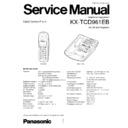Panasonic KX-TCD961EB Service Manual ▷ View online
|
41
|
KX-TCD961EB
1.10 FACTORY SERIAL PORT (SEE Fig. 31)
In order to communicate with the handset during manufacture and servicing (using a PC) a serial data link has been
provided. Serial data input/output is provided on J6 (TP65), and a ground is provided on J7. The bi-directional serial
data line is split into two at IC1 pin 27 (input) and pin 26 (output). Data rate is 9600 baud or 115.2 kBaud.
D13 provides ESD protection, and R37 and C56 provide RF de-coupling.
1.11 BUZZER CIRCUIT (SEE Fig. 35)
A square-wave signal from IC1 pin 45 is used to sound the buzzer via switching transistor T5 (TP22). Various tones
and cadences are used dependent on function. Buzzer volume is varied by changing the duty cycle of the drive
waveform. D11 provides quenching of back-emf generated when T5 turns off.
1.12 BATTERY SUPPLY (SEE Fig. 35)
The three cell NiCd/NiMH rechargeable battery supplies the handset via 2A fuse (actually a coil), and is de-coupled by
C3 and C4. It directly supplies T3 in the baseband section, and also the Tx PA in the RF Section. It also supplies IC1
(de-coupled by C9), and most of the RF Section (VCC-OC) (decupled by R35 and C47, C48 and VCC-PA).
1.13 MAIN 3V REGULATOR (SEE Fig. 35)
The BBIC measures the battery voltage on pins 58 using an internal ADC. If the battery voltage is below 3.36 V, TC3 is
switched to power off mode. R7 and C5 provide a reset pulse (TP84) used for resetting the BBIC when power on.
The +3 V supply (TP10) is fed to the BBIC, Flash PROM, EEPROM, and Display Driver.
1.14 BATTERY CHARGING CIRCUIT (SEE Fig. 35)
The charge circuit is designed to operate with a constant current charger in the base. L1, L2, D2 and D4 protect
against electro-static discharge (ESD). The charging current from the base is turned on and off by T1 using a control
signal from the BBIC (pin 39, TP6) via T2. R3 provides initial current in the event of a totally flat battery, and D6 pro-
tects against the high voltage present on the charge contacts if there is no battery in the handset. R4 and R5 provide a
signal for the BBIC to detect (pin 40) that the handset had been placed on the base charger. If the handset is off, it will
be switched on, and charging will start.
|
42
|
KX-TCD961EB
Fig. 35
Circuit Diagram
BUZZER
|
43
|
KX-TCD961EB
ADJUSTMENT (BASE UNIT)
Adjustment objectives
Tools required for adjustments
Frequency counter
Personal computer
Serial communication tool
Test software (batch files)
Line simulator
Oscillator
Audio level meter
Item(1)
1. Connect the serial link to test computer to J102 (serial data) and J103 (GND).
2. Connect the AC adaptor.
3. Connect the frequency counter to TP148 (SCLK) and J103 (GND).
4. Send batch file “FIXFREQ.BAT”.
5. Send “SETFREQ.BAT” to set the clock frequency. The default value is 80. Increase
the value to increase the frequency. The clock frequency must be
5,184,000 Hz ±7 Hz.
Adjustment item
Symptom
Synchronization with the portable handset is lost
immediately.
No link is established.
Remedy
Perform the adjustments described in item(1).
Clock frequency
|
44
|
KX-TCD961EB
Item(2)
1. Connect the serial link to test computer for J6 (serial data) and J8 (GND).
2. Connect a 3.9V supply to the handset.
3. Press the “power on” button.
4. Set the battery voltage to 4.6V at J1 and J2.
5. Send batch file “READBATT.BAT”. The returned hex value is M2.
6. Send batch file “WRTBATT.BAT M2”.
7. Set the battery voltage to 3.46V at TP87.
8. Send batch file “READBATT.BAT”. The returned hex value is M1.
9. Send batch file “WRTBATT.BAT M1”.
10. Calculate the low value 2 level:
11. Send “WRTBATT.BAT M3”.
ADJUSTMENT (HANDSET)
Adjustment objectives
Tools required for adjustments
Frequency counter
Power supply unit (DC 3V~5V, 1A)
Personal computer
Serial communication tool
Test software (batch files)
Item(1)
1. Connect the serial link to test computer to J6 (serial data) and J8 (GND).
2. Turn off power for the base unit.
3. Input a 3.9V supply to the handset J5 (+) and J8 (GND).
4. Connect the frequency counter to TP56 and J8 (GND).
5. Connect a frequency counter between TP6 (SCLK) and J8 (GND).
6. Press the “power on” button.
7. Send batch file “FIXFREQ.BAT”.
8. Use batch file “SETFREQ.BAT” to set the clock frequency. The default value is 80. Increase the value to increase
the frequency and vice-versa. The clock frequency must be 10,368.000 kHz ± 0.02 kHz.
Adjustment item
Symptom
Synchronization with the base unit is lost immediately.
No link is established.
Remedy
Perform the adjustments described in item(1).
Clock frequency
The communication (standby) times is short.
The low battery display period is too long or too short.
Perform the adjustments described in item(2).
Low battery
M3 Dec =
M1 Dec – (M2 Dec – M1 Dec) X 0.1
4.66 – 3.46
Click on the first or last page to see other KX-TCD961EB service manuals if exist.

